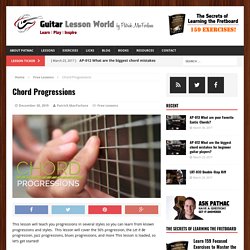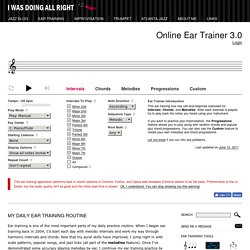

Chord Progressions. This lesson will teach you progressions in several styles so you can learn from known progressions and styles.

This lesson will cover the 50’s progression, the Let It Be progression, jazz progressions, blues progressions, and more This lesson is loaded, so let’s get started! The 50’s Progression I like to start with the 50’s progression because it is recognizable, playable in open position, and it only requires 4 chords. I’m going to give you a few examples using the major and minor CAGED chords and F chord thrown in. I’m going to give you three versions.
I-vi-IV-V This is the classic 50’s progression in the Key of C. I-vi-iv-V The Sleep Walk by Santo & Johnny variant switches the IV from a major to a minor chord, which is symbolized by the lower-case numerals. I-vi-ii-V This is a variant of the 50’s progression that I prefer. Pachelbel’s Canon Usually this is played in D, but it translates to guitar more easily in the key of G. Let it Be Progression This is an extremely popular progression.
Resources - Music Theory Is Your Friend. Musical Chords and Scales. Teoría - Music Theory Web. MusicalMind.org Ear Training Online. Interactive Circle of Fifths. Online Ear Training with Intervals, Melodies, and Jazz Chord Progressions. Loading ear trainer audio . . . 100% Use this form to save the current settings (active tab, tempo, options, etc) as an "exercise" which you can return to in the future.

Your Saved Exercises Play Mode Key Center Starting Cadence Display Options Repeat Count Repeat Modulation Intervals To Play Note Direction Sequence Type Root Note This ear training tool has call-and-response exercises for Intervals, Chords, and Melodies. If you want to practice jazz improvisation, the Progressions feature allows you to play along with random chords and popular jazz chord progressions.
Let me know if you run into any problems. Chords To Play All Even More Chords Inversions Note/Scale Options Each box is a... Melody Length Restrict to Single Octave This feature generates random melodies that you can use for sight-singing and call-and-response ear training. I recommend that you begin with "Single Note" mode and short 2- or 3-note melodies. Keys To Play Accompaniment Measures Per Chorus Chorus Count Stay in a Single Key? Scratchpad.
EQ Chart – ObiAudio. This is from a thread on Future Producers.

I copied and pasted the good stuff, enjoy: To understand EQ and its intricacies you need hands-on experience, but to help you get started, here’s a table of general uses and the different ranges that EQ can affect. As every sound is different, though, these are necessarily very general guidelines… Kick Drum Any apparent muddiness can be rolled off around 300Hz. 50-100Hz ~ Adds bottom to the sound 100-250Hz ~ Adds roundness 250-800Hz ~ Muddiness Area 5-8kHz ~ Adds high end presence 8-12kHz ~ Adds Hiss Snare Try a small boost around 60-120Hz if the sound is a little too wimpy. 100-250Hz ~ Fills out the sound 6-8kHz ~ Adds presence Hi hats or cymbals Any apparent muddiness can be rolled off around 300Hz. Key Color. Free software that simplifies songwriting - Hookpad.
In addition to being a great songwriting tool, Hookpad is a powerful MIDI creation platform.

With a single click, Hookpad's arrangement can be exported to MIDI and into a Digital Audio Workstation (Ableton Live, FL Studio, Logic Pro, GarageBand, ...) for additional production / modification. With intelligent harmony / chord fills, and the ability to independently shift the tonal center of each track, incorporating Hookpad into your workflow will enhance your creativity and productivity as a songwriter or producer. Need a quick pad fill for C → G → am → F? Drop those chords into Hookpad, tweak the mix to your liking, send to MIDI, and in less than a minute, you are on to the next thing. Start from a song you already love. The Theorytab database is a huge collection of real songs written out with Hookpad. If you want to learn more how chords and melody work, check out Hooktheory I, our interactive text for the Web and iPad that serves as a companion for Hookpad and the Theorytab database. The Ultimate Guide To Songwriting.
Earlier this year, our Cubase and Digital Editor Andy Price analysed various key elements of songwriting while using his DAW of choice: Cubase Pro 8.

From basic song structures, the importance of keys, the art of melody to elements of harmony. On this page we roundup these guides. It’s the MusicTech ultimate guide to songwriting.